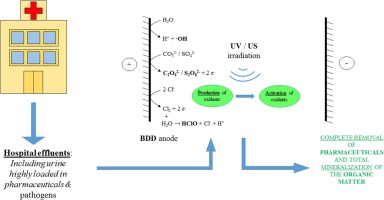当前位置:
X-MOL 学术
›
Water Res.
›
论文详情
Our official English website, www.x-mol.net, welcomes your
feedback! (Note: you will need to create a separate account there.)
Electrolytic and electro-irradiated technologies for the removal of chloramphenicol in synthetic urine with diamond anodes
Water Research ( IF 11.4 ) Pub Date : 2017-11-01 , DOI: 10.1016/j.watres.2017.10.072 Salvador Cotillas , Engracia Lacasa , Cristina Sáez , Pablo Cañizares , Manuel A. Rodrigo
Water Research ( IF 11.4 ) Pub Date : 2017-11-01 , DOI: 10.1016/j.watres.2017.10.072 Salvador Cotillas , Engracia Lacasa , Cristina Sáez , Pablo Cañizares , Manuel A. Rodrigo

|
Hospital effluents are a major source for the occurrence of pharmaceuticals in the environment. In this work, the treatment of synthetic urine polluted with chloramphenicol is studied by using three different conductive-diamond electrochemical oxidation technologies: electrolysis (single electrolysis), photoelectrolysis and high-frequency ultrasound sonoelectrolysis. These technologies were evaluated at 10 and 100 mA cm-2. Results shows that not only chloramphenicol but also other organics contained in urine are completely mineralized by electrolysis. Ammonium is the main inorganic nitrogen species formed and it can react with the electrogenerated hypochlorite, favouring the formation of chloramines. These species prevent the potential formation of perchlorate from chlorides contained in urine at low current densities (10 mA cm-2) and delay its occurrence at high current densities (100 mA cm-2). On the other hand, irradiation of ultraviolet (UV) light or high-frequency ultrasound (US) produce changes in the performance of the electrolytic treatment, but these changes are not as important as in other cases of study shown in the literature. Nonetheless, the effect of electroirradiated technologies seems to be higher and depends on the type of pollutant when working at low current densities (10 mA cm-2). It is positive in the case of the degradation of the antibiotic and the uric acid and negative in the case of urea where there is a clear antagonistic effect. Production of oxidants increases with the current density although in lower ratio than expected. These results are of great importance because clearly point out that electrolytic technologies can be applied to minimize the diffuse pollution associated to pharmaceuticals before discharge into municipal sewers.
中文翻译:

电解和电辐照技术用金刚石阳极去除合成尿中的氯霉素
医院废水是环境中药物出现的主要来源。在这项工作中,研究了使用三种不同的导电金刚石电化学氧化技术处理被氯霉素污染的合成尿:电解(单次电解),光电解和高频超声声电解。在10和100 mA cm -2下评估了这些技术。结果表明,不仅氯霉素,而且尿液中所含的其他有机物也可通过电解完全矿化。铵是形成的主要无机氮物质,它可以与电生成的次氯酸盐反应,有利于氯胺的形成。这些物质可防止在低电流密度(10 mA cm -2)下尿液中的氯化物可能形成高氯酸盐,并在高电流密度(100 mA cm -2)时延迟其发生。)。另一方面,紫外线(UV)或高频超声(US)的照射会产生电解处理性能的变化,但这些变化并不像文献中显示的其他研究情况那样重要。但是,在低电流密度(10 mA cm -2)下工作时,电辐照技术的效果似乎更高,并且取决于污染物的类型。)。在抗生素和尿酸降解的情况下为阳性,而在具有明显拮抗作用的尿素的情况下为阴性。氧化剂的产生随电流密度的增加而增加,尽管其比率低于预期。这些结果非常重要,因为清楚地指出,在排入市政下水道之前,可以采用电解技术来最大程度地减少与药物相关的扩散污染。
更新日期:2017-11-01
中文翻译:

电解和电辐照技术用金刚石阳极去除合成尿中的氯霉素
医院废水是环境中药物出现的主要来源。在这项工作中,研究了使用三种不同的导电金刚石电化学氧化技术处理被氯霉素污染的合成尿:电解(单次电解),光电解和高频超声声电解。在10和100 mA cm -2下评估了这些技术。结果表明,不仅氯霉素,而且尿液中所含的其他有机物也可通过电解完全矿化。铵是形成的主要无机氮物质,它可以与电生成的次氯酸盐反应,有利于氯胺的形成。这些物质可防止在低电流密度(10 mA cm -2)下尿液中的氯化物可能形成高氯酸盐,并在高电流密度(100 mA cm -2)时延迟其发生。)。另一方面,紫外线(UV)或高频超声(US)的照射会产生电解处理性能的变化,但这些变化并不像文献中显示的其他研究情况那样重要。但是,在低电流密度(10 mA cm -2)下工作时,电辐照技术的效果似乎更高,并且取决于污染物的类型。)。在抗生素和尿酸降解的情况下为阳性,而在具有明显拮抗作用的尿素的情况下为阴性。氧化剂的产生随电流密度的增加而增加,尽管其比率低于预期。这些结果非常重要,因为清楚地指出,在排入市政下水道之前,可以采用电解技术来最大程度地减少与药物相关的扩散污染。











































 京公网安备 11010802027423号
京公网安备 11010802027423号